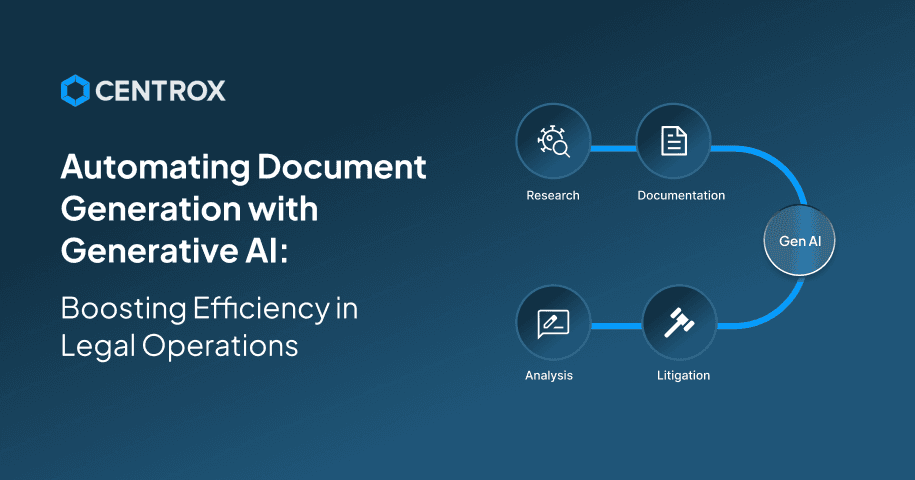AI Document Generation for Boosting Legal Process Efficiency
Discover how AI models power legal document generation, enabling contracts, compliance, case briefs, certificates, and document comparison.
9/7/2025
artificial intelligence
7 mins

Even in the 21st century, documenting legal processes consumes much time. This further delays proceedings, making legal processes late and inefficient. Here, an AI Document Generator can prove to be a revolutionary tool, which can simultaneously generate documents tailored for different scenarios.
AI document generation can indeed help generate contextually accurate, factually validated documents and smartly automate this routine document generation task. This not only speeds up the entire cycle, making the whole procedure more convenient for both the lawyers and clients.
With our blog on AI Document Generation, we will help you understand which Gen AI model can power this application and its specialized use cases for the legal industry. This will help you understand how adopting this for your legal business will help you achieve better work efficiency and client satisfaction.
AI Document Generation
AI document generators use specialized Gen AI models to automatically create structured documents, such as reports, contracts, blogs, or proposals. This tool analyzes data by applying templates and eventually produces human-like text, saving time, improving accuracy, and enhancing productivity for businesses and legal service providers.
Why AI Document Generation is Important for Legal Workflows?
Traditionally, getting legal documents prepared is a time and effort-intensive task. As there is a high influx of people who need such support for tasks. Additionally, not having enough human resources for handling and executing these document generation tasks further delays the process. Here, highly depending on humans for completing this redundant task is very expensive.
For everyday tasks like getting, domicile, birth/death certificate, CNIC, or making legal contracts, an AI-driven tool can emerge as a lifesaver that makes processes easy. As these tools can function as a one-window operator, listening to users' queries, supporting them, asking them to provide relevant documents, and generating the relevant document within in few minutes then and there. Marc Andressen( American businessman) says:
“AI will not destroy jobs; it will destroy tasks. That’s a big difference.”
This saying highlights that AI-powered tools for document generation will emerge as an intelligent assistant. This assistant will perform several tasks in an optimized and efficient manner, allowing human lawyer to invest their energy and critical thinking in more important tasks.
Gen AI Models Powering Automated Document Generation
Generative AI holds immense potential for making workflows smarter, faster, and optimized. For applications like automated document generation, a Gen AI-driven tool can work to understand user requirements, extend support, and eventually generate a relevant legal document. For your convenience, we have listed a few Gen AI models that handle the duty of creating legal documents:
1. Transformers (e.g., GPT, LLaMA, Claude, PaLM)
- How it Works: “Transformers are based on a self-attention mechanism that understands the relation between each word, generates coherent sequences, and handles long context for structured, accurate document creation.” (Ashish et al., 2023)
- Applications it can support: Draft contracts, policies, client letters, case briefs, compliance reports, and legal templates.
- Benefit: Transformers are highly accurate, scalable, and adaptable across industries, and therefore, they hold strong contextual understanding and can support natural language queries.
- Challenges: A Transformer might require a high compute cost, which can cause hallucinations, data privacy risks, and regulatory compliance issues within the generated response.

2. Recurrent Neural Networks (RNNs)
- How it Works: “RNNs work by processing text sequentially. It remembers the past words via hidden states, generating documents word by word with contextual flow. This ability makes these models suitable for generating contextually accurate tests for documents.” (Tomas et al., 2010)
- Application it can support: Simple contract templates, email drafting, procedural legal documents.
- Benefit: RNNs are lightweight, which makes them faster for executing small tasks and ultimately makes them easily interpretable.
- Challenges: However, these RNNs struggle with long documents and are outdated compared to transformers, and therefore might result in responses with weaker accuracy.

3. Hybrid Models (Mixture-of-Experts, Retrieval-Augmented Generation)
- How it Works: “The Hybrid model works by combining large language model text generation with external databases or knowledge retrieval to ensure that the generated outputs are coherent, factually accurate, and reliable for users.” (Yizheng et al., 2024)
- Application it can support: Legal research memos, compliance reports, case-specific contracts, citation-rich documents.
- Benefit: Hybrid models help in contributing higher accuracy, reducing hallucinations, and allowing for domain-specific specialization, since they ground output in verified sources, significantly improving trust and usability.
- Challenges: They face integration complexity, reliance on database quality, and infrastructure demands, requiring continuous updates, secure system management, and significant resources to ensure reliability and scalability in professional legal operations.

Use Cases of Automated Document Generation for Legal Work
Gen AI-powered automated document generation tool can be utilized for performing several responsibilities that come under the legal workflow. By executing these tasks, it not only saves time but also significantly minimizes workload, and allows professionals to focus on providing quality legal advisory.
1. Contract Drafting and Review
An AI document generation tool can be used to draft standard legal contracts (NDAs, employment agreements, vendor contracts). It can quickly overview the entire document and identify risky clauses, while suggesting a better alternative.
2. Compliance and Regulatory Reports
Such Automated tools can produce compliance documents, audit summaries, and regulatory filings that are tailored according to a specific legal framework, which has reduced errors and can ensure timely submissions.
3. Certificates and Licenses
This AI document generation tool can also generate Everyday documents like domicile certificates, birth/death certificates, and licenses. Thus, it provides an efficient alternative for the traditional manual process by eliminating delays for both individuals and institutions.
4. Case Briefs and Legal Research Memos
This AI can act like a smart assistant that can summarize case law, generate briefs, and create well-structured memos supported by citations from legal databases, making case preparation easy and fast.
5. Client Communication Documents
With this automated document generation tool, we can draft formal notices, letters, agreements, or advisory reports. This will help the legal experts in preparing faster and more consistent documents, which will enhance client satisfaction.
6. Comparing Cases and Documents
This AI tool can be utilized for analyzing and comparing multiple contracts, case files, or regulations side by side, as it can highlight differences, similarities, and risks, ultimately assisting in faster, more accurate decision-making.
Why Automate Legal Document Processes Now
Generative AI is transforming legal operations by automating document creation, cutting costs, and improving efficiency. From contracts and NDAs to compliance reports and certificates, AI models like Transformers, RNN, and hybrid systems enable faster, consistent, and scalable outputs.
This shift reduces dependency on manual work and frees legal teams to focus on strategic, high-value tasks. For decision-makers, the path is clear: start with high-volume, low-risk documents to secure quick ROI, pilot automation in focused areas before scaling, and adopt hybrid models for accuracy and compliance.
Prioritizing secure, regulation-compliant AI tools ensures trust and safety. Acting now positions organizations to stay competitive, streamline operations, and embrace the digital future of legal services.
Are you ready to cut costs, reduce delays, and transform legal workflows by automating document generation with AI today? Get in touch with our experts at Centrox AI, and let's collaborate to explore the best possible solution.

Muhammad Haris Bin Naeem
Muhammad Harris Bin Naeem, CEO and Co-Founder of Centrox AI, is a visionary in AI and ML. With over 30+ scalable solutions he combines technical expertise and user-centric design to deliver impactful, innovative AI-driven advancements.
Do you have an AI idea? Let's Discover the Possibilities Together. From Idea to Innovation; Bring Your AI solution to Life with Us!
Your AI Dream, Our Mission
Partner with Us to Bridge the Gap Between Innovation and Reality.
